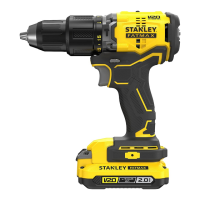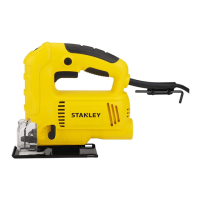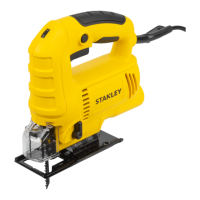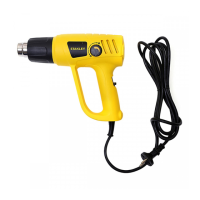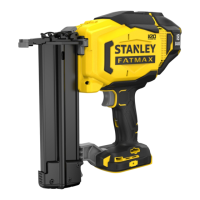ENGLISH (Original Instructions)
20
using a fork wrench. Tilt the table into the desired position
and retighten the hexagonal bolt.
WARNING! A kickback occurs when work-piece suddenly
binds on the cutting edge of the tool and the work-piece is
thrown by the cutter in the direction of the cutter’s rotation.
This can cause serious injury. It is important the workpiece
is securely clamped or held down before drilling.
Chuck Guard
It provides protection from quill to drill point allowing a
smooth telescopic action as the drill penetrates the work-
piece.
Installing Drill Bit in Chuck (Fig. H)
1. With the switch “OFF” and the switch key removed,
open the chuck jaws (21) using the chuck key (23).
Turn the chuck key counterclockwise to open the
chuck jaws (21).
2. Insert thedrill bit (22) into the chuck far enough to ob-
tain maximum gripping by the jaws, but not far enough
to touch the spiral grooves (utes) of the drill bit when
the jaws are tightened.
3. Make sure that the drill is centered in the chuck.
4. Turn the chuck key clockwise to tighten the jaws.
WARNING! To avoid injury or accident by the chuck key
ejecting forcibly from the chuck when the power is turned
“ON”, use only the self-ejecting chuck key supplied with
this drill press. ALWAYS recheck and remove the chuck key
before turning the power “ON”.
MAINTENANCE
Your Stanley corded/cordless appliance/tool has been
designed to operate over a long period of time with a
minimum of maintenance. To ensure satisfactory operations,
the tool must be maintained and cleaned regularly. At the
same tool can not be serviced by the user. Take the tool to
an authorized repair agent Stanley. Service must be given
to this tool to regulators intervals or when it shows a marked
change in performance.
WARNING! To minimize the danger of serious
personal injury, please switch off the tool power and
disconnect all plugs before adjusting or removing/
installing any accessory. Before reassembling the tool,
press and release the trigger switch to make sure the tool is
already switched off.
If operated under extremely dusty conditions, operate at
the slowest speeds to avoid rapid abrasive wear on the
moving parts and lubricate the machines more often.
Under extreme cold conditions, start at a slow speed and
allow the parts and lubricants to warm up before
increasing the speeds.
Lubrication
Stanley tools are properly lubricated at the factory
and are ready for use.
Tools should be lubricated regularly every year depending
on usage. (Tools used on heavy duty jobs and tools
exposed to heat may require more frequent lubrication.)
This lubrication should be attempted only by trained power
tool repairperson’s such as those at Stanley service centers
or in other qualified service personnel.
Cleaning
WARNING! Dust and grit from metal
grinding often accumulate on interior
surfaces and could create an electrical
shock hazard if not cleaned out. Use only mild soap
and a damp cloth to clean the tool. Never let any
liquid get inside the tool; never immerse any part of
the tool into a liquid.
WARNING! Never use solvents or harsh
chemicals to clean non-metal parts of the
tool. These chemicals may weaken the material of
the parts. Use only mild soap and damp cloth to
clean the tool. Never let any liquid get inside the
tool; never immerse any part of the tool into liquid.
WARNING! Do not overload your angle
grinder. Overloading causes a reduction in
speed and efficiency, causing your angle grinder to
become too hot. If this happens, operate your
angle grinder under no load for one or two minutes
until it has cooled to normal operating temperature.
Switching your angle grinder off under load will
reduce the life of the switch.
¡IMPORTANT! To ensure product SAFETY
and RELIABILITY, repairs, maintenance and
adjustment (other than those listed in this
manual) should be performed by authorized
service centers or other qualified organizations,
always using identical replacement parts. Unit
contains no user service able parts inside.
Optional Accessories
WARNING! Since accessories, other than those
offered by Stanley, have not been tested with this
product, use of such accessories with this tool could be
hazardous. To reduce the risk of injury, only Stanley,
recommended accessories should be used with this product.
The performance of any power tool is dependent upon the
accessory used. Stanley accessories are engineered to
high quality standards and are designed to enhance the
performance of power tool. By using Stanley accessories
will ensure that you get the very best from your Stanley tool.
Stanley offers a large selection of accessories available at
our local dealer or authorized service center at extra cost.
♦ Do not install or use any drill bit that exceeds 7” in
length or extends 6” below the chuck jaws. They could
suddenly bend outward or break.
♦ Direction of feed for drum sanding. Feed work-piece
into a sanding drum, or other approved accessory,
against the direction of rotation.
♦ Sandingdrumsareaveryusefulaccessory,butthearbor
of a drill press is not designed for sideways pressure.
Don’t push too hard when sanding, this could transfer a
great deal of stress to the shaft.
♦ Drum sanders must be operated at a speed under
1000rpm.
♦ For hole cutters keep speed below 800rpm.
Terms
♦ Throat depth: Distance between the center of the
spindle (where the bit goes) and front edge of the
column.
